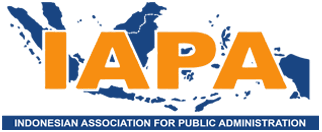E-Government as Public Sector Innovation
DOI:
https://doi.org/10.21776/ub.jpas.2019.004.02.8Keywords:
Information and Communication Technologies (ICTs), e-government, innovation, critical success factorsAbstract
Information and communication technologies (ICTs) have a critical role in public sector. The use of ICT in service innovation to citizens is known as e-government. E-government as public sector innovation presents a higher quality, cost-effective, government services and a better relationship between citizen and government. On the other hand study conducted by Lee (2009) show the implementation of e-government in many countries is not in line with expectations. The purpose of this paper is to discuss what factors influence the success of e-government as public sector innovation.
This research used systematic literature review method to conduct a brief selective review of CSF (critical success factors) in implementing e-government. The outcome of the finding there are several critical success factors (CSF) that influence e-government as public sector innovations consist of planning, organizational structure, organizational culture, policy, human resources, leadership, communication, coordination and collaboration, and awareness. Thus defining CSF especially in implementing e-government will help public organizations avoid the failure of e-government projects.
References
Australian National Audit Office. (2009). Innovation in the Public Sector: Enabling Better Performance, Driving New Directions. DPU: Australia.
Altameem, T. Zairi M. & Alshawi, S. (2006). Critical Success Factors of E-Government: A Proposed Model for E-Government Implementation. IEEE Conference Publications.
Bullen, C. & Rockhart, J. (1981). A Primer on Critical Success Factors. Cambridge, MA: Center for Information System Research, MIT.
Bwalya, K. J. (2009). Factors Affecting Adoption of E-Government in Zambia. The Electronic Journal on Information System in Developing Countries, 38(4) pp. 1-13
Heeks, R. (2003). Most E-Government for Development Projects Fail: How Can Risks be Reduced? Manchester: Institute for Development Policy and Management.
Deliza, H. (2006). Tinjauan Penggunaan CSF dan Audit Grid dalam Analisis Aplikasi Sistem Informasi. Jurnal Akuntansi, 2(6) pp. 205-212.
Indrajit, R. E. (2006). Electronic Government: Strategi Pembangunan dan Pengembangan Sistem Pelayanan Publik Berbasis Teknologi Digital. Yogyakarta: Penerbit Andi Offset.
Lessa, L., Nagash, S. & Belachew, N. (2012). Steering e-government Project from Failure to Succes: Using Design-Reality GAP analysis as a Mild- Implementation Assesment Tool. iGovernment Working Paper Number 3240.
Luhan, J. & Novotná, V. (2015). ICT use in EU according to national models of Behavior. Procedia – Social and Behavioural Sciences 213, 80-85.
Rogers, E. M. (2003). Diffusion of Innovations – Fifth Edition. New York: The Free Press.
Susetyo, W. & Pawellangi, M. R. (2011). Implementasi E-Learning pada bidang keahlian Teknologi Informasi dan Komunikasi (TIK) SMK di Kota Malang. Jurnal Pendidikan Teknologi Kejuruan, 7(1).
Published
Issue
Section
License
Copyright Statement
Authors who publish with JPAS agree to the following terms:
(1). Authors retain copyright and grant the journal right of first publication with the work simultaneously licensed under a Creative Commons Attribution License that allows others to share the work with an acknowledgement of the work's authorship and initial publication in this journal.
(2). Authors are able to enter into separate, additional contractual arrangements for the non-exclusive distribution of the journal's published version of the work (e.g., post it to an institutional repository or publish it in a book), with an acknowledgement of its initial publication in this journal.
(3). Authors are permitted and encouraged to post their work online (e.g., in institutional repositories or on their website) prior to and during the submission process, as it can lead to productive exchanges, as well as earlier and greater citation of published work (See The Effect of Open Access).
Permissions and reuse
For authors
Authors may use their own articles for the following non-commercial purposes without asking our permission (and subject only to acknowledging first publication in JPAS and giving a full reference or web link, as appropriate).
(1). Posting a pdf of their own article on their own personal or institutional website, for which no charge for access is made.
(2). Making a reasonable number of copies for personal or non commercial professional use.
This includes the contributors own teaching purposes.
(1). Republishing part or all of the article in a book or other publication edited by the author (except for multiple contributions in the same book or publication, for which permission needs to be sought.
(2). Using individual figures or tables or extracts of text (up to 300 words) in other publications published by a third party.
(3). Using the article in a course pack or compilation (whether paper or electronic) in the authors institution. This does not apply if a commercial charge is made for the compilation or training programme.
For third parties
All articles published by JPAS are published by default as open access.















